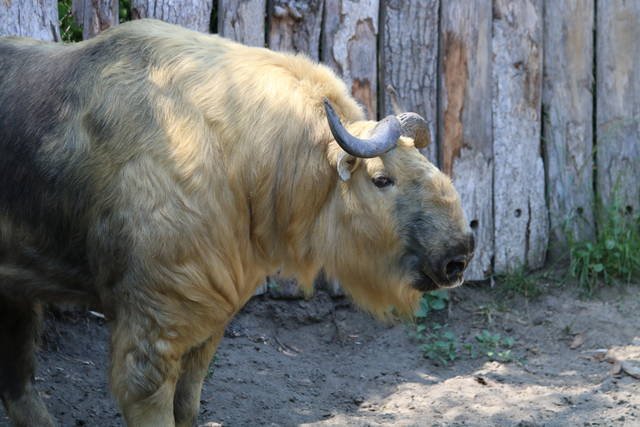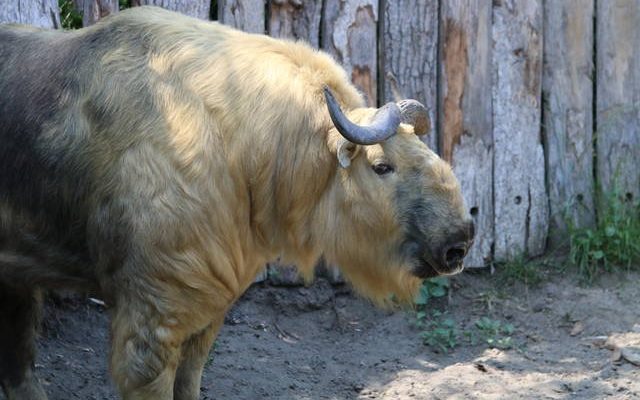
Imagine spotting a takin in the wild: its shaggy coat and robust build against the backdrop of rugged mountains. They seem peaceful, munching on grass or leaves. However, like any wild animal, they can be unpredictable. So, it’s essential to understand their nature and behaviors to grasp whether they can pose any threat to humans.
What is a Takin?
To get started, let’s clarify what a takin actually is. The takin belongs to the Bovidae family, which features animals like cows and goats. They have thick, golden-brown fur that keeps them warm in their cold mountain habitats. You might be surprised to learn that takins are related to the bison and the antelope, despite their peculiar looks.
There are two main species of takin: the Sichuan takin and the Musk takin. They can weigh between 300 to 800 pounds and stand about 3 to 4 feet at the shoulder. This hefty frame helps them navigate steep, rocky terrains where they live, primarily in the mountain ranges of China, Bhutan, and India. Living in herds, these animals display social behavior that adds depth to their character.
Like many animals, takins are herbivores, enjoying a diet of leaves, shrubs, and grasses. Their unique adaptations help them survive harsh weather conditions, showcasing nature’s ability to equip animals for survival.
Are Takins Aggressive Towards Humans?
You might be wondering whether takins are naturally aggressive or if they pose any real threat to humans. Generally, takins are not known for being aggressive creatures. They mostly prefer to keep to themselves and graze in peace. However, if they feel cornered or threatened, they can react defensively.
Think of it this way: if you were approached by someone too close for comfort, you might also feel the urge to protect yourself. Similarly, takins might charge if they sense danger, especially during mating season when hormones and instincts are heightened. That said, the risk of a takin actively seeking out humans to attack is low.
Most encounters between takins and humans happen in remote areas or national parks. If you stick to the trails and keep a respectful distance, you’re likely to enjoy observing these fascinating animals without incident.
Understanding Takin Behavior
To better assess the potential dangers of takins, it’s helpful to understand their behavior. Takins are generally shy and prefer to avoid confrontation. They spend much of their time grazing and foraging for food, rarely engaging in aggressive displays unless provoked.
In social structures, takins live in herds, often led by dominant males. They communicate through various vocalizations and body language, from snorts to posturing, to establish dominance or warn off others. Recognizing these signs can help people understand when a takin might feel threatened.
Their defensive behaviors include charging or lunging, which can seem daunting due to their size. However, it’s essential to remember that such reactions are typically a response to fear rather than aggressive intent.
Encounters with Takins: Safety Tips
If you’re planning a trip to observe takins in their natural habitat, it’s always wise to prioritize safety. Here are some practical tips to keep in mind:
- Keep a Safe Distance: Use binoculars or a camera with a zoom lens to enjoy watching takins without disturbing them.
- Stay on Designated Trails: This helps minimize your chances of accidentally startling them.
- Observe Their Body Language: If they start snorting, stomping, or charging, give them space and back away calmly.
- Never Feed Wild Animals: Feeding takins can condition them to associate humans with food, leading to potential aggression.
By following these simple guidelines, you can enjoy your experience in a way that respects both the takins and your safety.
Comparing Takins to Other Wild Animals
While it’s natural to fear wild animals, it’s helpful to put their potential danger into perspective. Comparing takins to other animals like bears or even bison can provide context.
For example, bears are generally more dangerous because they can exhibit predatory behavior and can be aggressive when protecting their cubs. On the other hand, takins, being largely herbivorous and more on the timid side, have a much lower risk of posing a serious threat.
Another comparison could be made with moose, known for being unpredictable and aggressive, especially during mating season. Overall, takins are more akin to large, docile animals rather than aggressive predators.
Why It Matters to Understand Takin Behavior
Understanding how takins interact with their environment and humans is important for both conservation and personal safety. With their populations declining due to habitat loss and hunting, respecting these majestic creatures contributes to their preservation.
By educating ourselves about takin behavior and their natural habitat, we can foster a better coexistence—a key to protecting wildlife for future generations.
Additionally, awareness of their nature can help maintain a healthy respect for wild animals in general. The more we know, the better equipped we are to enjoy and protect both humans and wildlife alike.
So, can the takin be dangerous to humans? In essence, while they aren’t inherently dangerous, like all wild animals, they can react defensively if they feel threatened. If we approach them with respect and understanding, we’re more likely to have safe and enjoyable encounters.
Next time you spot one of these remarkable animals, remember to appreciate their uniqueness while practicing caution. As with many aspects of nature, it’s all about balance. Let’s continue to learn from and cherish the stunning creatures, like takins, that share our planet.

